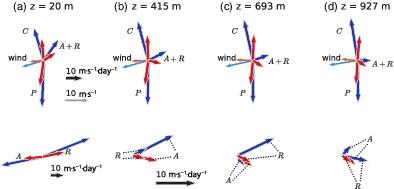当前位置:
X-MOL 学术
›
Q. J. R. Meteorol. Soc.
›
论文详情
Our official English website, www.x-mol.net, welcomes your
feedback! (Note: you will need to create a separate account there.)
The role of shallow convection in the momentum budget of the trades from large-eddy-simulation hindcasts
Quarterly Journal of the Royal Meteorological Society ( IF 3.0 ) Pub Date : 2021-04-06 , DOI: 10.1002/qj.4035 K. C. Helfer 1 , L. Nuijens 1 , V.V. Dixit 1
Quarterly Journal of the Royal Meteorological Society ( IF 3.0 ) Pub Date : 2021-04-06 , DOI: 10.1002/qj.4035 K. C. Helfer 1 , L. Nuijens 1 , V.V. Dixit 1
Affiliation

|
Motivated by the abundance of low clouds in the subtropics, where the easterly trade winds prevail, we study the role of shallow convection in the momentum budget of the trades. To this end, we use ICON-LEM hindcasts run over the North Atlantic for 12 days corresponding to the NARVAL1 (winter) and NARVAL2 (summer) flight campaigns. The simulation protocol consists of several nested domains, and we focus on the inner domains (≈100 × 100 km2) which have been run at resolutions of 150–600 m and are forced by analysis data, thus exhibiting realistic conditions. Combined, the resolved advection and the subgrid stresses decelerate the easterly flow over a frictional layer that balances the prevailing geostrophic wind forcing. Irrespective of the horizontal resolution, this layer is about 2 km deep in the strong winter trades and 1 km in summer, as winds and geostrophic forcing weaken and cloudiness reduces. The unresolved processes are strongest near the surface and are well captured by traditional K-diffusion theory, but convective-scale motions which are not considered in K-diffusion theory contribute the most in the upper part of the mixed layer and are strongest just below cloud base. The results point out that convection in the mixed layer – the roots of trade-wind cumuli and subcloud-layer circulations – play an important role in slowing down easterly flow below cloud base (but little in the cloud layer itself), which helps make the zonal wind jet more distinct. Most of the friction within the clouds and near the wind jet stems from smaller-scale turbulence stresses.
中文翻译:

浅对流在大涡模拟后报交易动量预算中的作用
受东风信风盛行的亚热带地区大量低云的推动,我们研究浅层对流在贸易动量收支中的作用。为此,我们使用与 NARVAL1(冬季)和 NARVAL2(夏季)飞行活动相对应的 ICON-LEM 后报,在北大西洋上空运行 12 天。模拟协议由几个嵌套域组成,我们专注于内部域(≈100 × 100 km 2) 已在 150-600 m 的分辨率下运行并受分析数据的影响,因此表现出现实条件。结合起来,解决的平流和次网格应力使东风流在摩擦层上减速,该摩擦层平衡了盛行的地转风力。无论水平分辨率如何,随着风和地转强迫减弱和云量减少,该层在冬季强时深约 2 公里,夏季深约 1 公里。未分辨的过程在地表附近最强,传统的 K 扩散理论很好地捕捉到了,但 K 扩散理论中没有考虑的对流尺度运动在混合层的上部贡献最大,在云层下方最强根据。结果指出,混合层中的对流——信风积云和子云层环流的根源——在减缓云底以下的东风流方面发挥着重要作用(但在云层本身中很少),这有助于使纬向风急流更加鲜明。云中和风射流附近的大部分摩擦源于较小尺度的湍流应力。
更新日期:2021-06-03
中文翻译:

浅对流在大涡模拟后报交易动量预算中的作用
受东风信风盛行的亚热带地区大量低云的推动,我们研究浅层对流在贸易动量收支中的作用。为此,我们使用与 NARVAL1(冬季)和 NARVAL2(夏季)飞行活动相对应的 ICON-LEM 后报,在北大西洋上空运行 12 天。模拟协议由几个嵌套域组成,我们专注于内部域(≈100 × 100 km 2) 已在 150-600 m 的分辨率下运行并受分析数据的影响,因此表现出现实条件。结合起来,解决的平流和次网格应力使东风流在摩擦层上减速,该摩擦层平衡了盛行的地转风力。无论水平分辨率如何,随着风和地转强迫减弱和云量减少,该层在冬季强时深约 2 公里,夏季深约 1 公里。未分辨的过程在地表附近最强,传统的 K 扩散理论很好地捕捉到了,但 K 扩散理论中没有考虑的对流尺度运动在混合层的上部贡献最大,在云层下方最强根据。结果指出,混合层中的对流——信风积云和子云层环流的根源——在减缓云底以下的东风流方面发挥着重要作用(但在云层本身中很少),这有助于使纬向风急流更加鲜明。云中和风射流附近的大部分摩擦源于较小尺度的湍流应力。











































 京公网安备 11010802027423号
京公网安备 11010802027423号